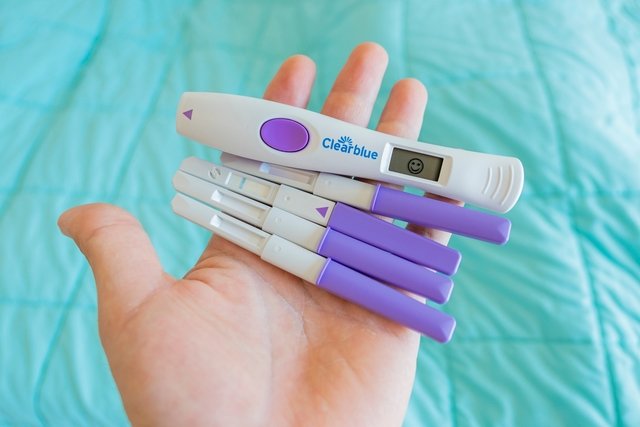The ovulation test is a method of identifying when a woman is in the ovulatory phase of the menstrual cycle, which is when there is a greater chance of pregnancy. For this reason, this test is often used by women who are trying to get pregnant.
The ovulation test is simple and easy to do at home, just place the tip of the test for a few seconds in a urine sample, as it is capable of detecting the concentration of luteinizing hormone (LH), which is increased during the ovulatory phase. of the menstrual cycle.
Whenever there is doubt about using this type of test, or whenever you want to find out the best period to get pregnant, it is recommended to consult a gynecologist, who will carry out a detailed assessment and guide the woman on the best practices to increase the chances of success.

How to take the ovulation test
The ovulation test, both the strip and the digital test, are simple and quick tests, and should be carried out as follows:
1. Strip test
To use the strip or tape test, you can urinate directly on the strip, or use a bottle provided in the package to collect a quantity of urine and then place the strip inside the bottle with the urine, for at least 30 seconds, following the line on the strip that represents the maximum level of urine in the bottle.
Then, place the strip on a flat surface and wait at least 5 minutes to observe the result.
Care when taking the test: It is important to do the ovulation test with the strip every day at the same time, and it is recommended to collect urine between 10 am and 10 pm. You should not use your first urine in the morning to take the test and you should not reuse the strips.
Furthermore, it is recommended to avoid consuming liquids for at least 2 hours before taking the test, as more diluted urine may not measure the amount of the LH hormone.
2. Digital ovulation test
To take the digital ovulation test, you must remove the test meter from the packaging, as well as its protective cap. Then remove the protective cap from the test stand.
Insert the test meter into the tip of the test support, aligning the two pink arrows, until you hear a click and see the message “test ready”, which should appear on the test support display.
Then, urinate into the test meter for 5 to 7 seconds, pointing it downwards, being careful not to wet the support. Another option is to urinate into a clean, dry bottle and dip the test meter into the urine for 1 second.
Then, place the lid on the meter and clean off excess urine, and place the test stand on a flat surface or tilted downwards, with the meter facing downwards.
The “test ready” symbol should start flashing after 20 to 40 seconds. Then you must wait 3 minutes to obtain the result.
Pre-test precautions: It is important to prepare the test before taking the measurement, and it is important to follow the instructions that come with the packaging.
Furthermore, you should avoid urinating for at least 4 hours before taking the test, so that the urine is more concentrated. This digital test can be done with any urine of the day, but always at the same time.
How to know if the ovulation test is positive
The result of the ovulation test varies according to the concentration of LH circulating in the woman’s body and the test that is performed, so the results observed may be:
- Ribbon test: the presence of two lines should be observed, one corresponding to the control and the other to the woman’s LH concentration. The presence of two lines of the same intensity indicates a positive test, while the presence of just one line or two lines with very different intensities indicates a negative test. It is important that the test result is checked in the information leaflet that accompanies it;
- Digital test: The test is said to be positive when a happy face appears on the test display, while in a negative test only a circle appears.
These tests are capable of detecting the ovulatory peak, that is, the phase of the cycle in which there is a greater concentration of LH, so that pregnancy is more likely to occur.
Therefore, a negative result does not necessarily mean that the woman is not in the ovulatory phase of the menstrual cycle, but that there may or may not have already been an LH peak and, therefore, it is recommended that the test be carried out the following day on the same day. time.
Does the home ovulation test work?
The home ovulation test involves inserting the tip of your index finger into the vagina and removing a small amount of mucus. When rubbing this mucus on the tip of your thumb, you should observe its color and consistency.
It is likely that the woman is in her fertile period if this vaginal mucus is transparent, fluid and not very sticky, similar to egg white, however, it is important for the person to know that pharmacy tests are much more accurate, as they can It can be difficult to interpret the consistency of the mucus, and this method does not indicate the best day to get pregnant.
Bibliography
- SU, HW; et al. Detection of ovulation, a review of currently available methods. Bioeng Transl Med. 2. 3; 238-246, 2017
- ALAMAR TECNO CIENTÍFICA LTDA. Confirm Fertility – ovulation test with ribbons. Available at: <http://confirme.com.br/bulas/IU_Fertidade_5un_SITE.pdf>. Accessed on 17 Jul 2023
- CLEAR BLUE. Clear Blue – digital ovulation test. 2020. Available at: <https://br.clearblue.com/sites/default/files/wysiwyg/products/leaflets/733294_0.pdf>. Accessed on April 20, 2022

Sign up for our newsletter and stay up to date with exclusive news
that can transform your routine!
Warning: Undefined array key "title" in /home/storelat/public_html/wp-content/plugins/link-whisper-premium/templates/frontend/related-posts.php on line 12
Warning: Undefined array key "title_tag" in /home/storelat/public_html/wp-content/plugins/link-whisper-premium/templates/frontend/related-posts.php on line 13



